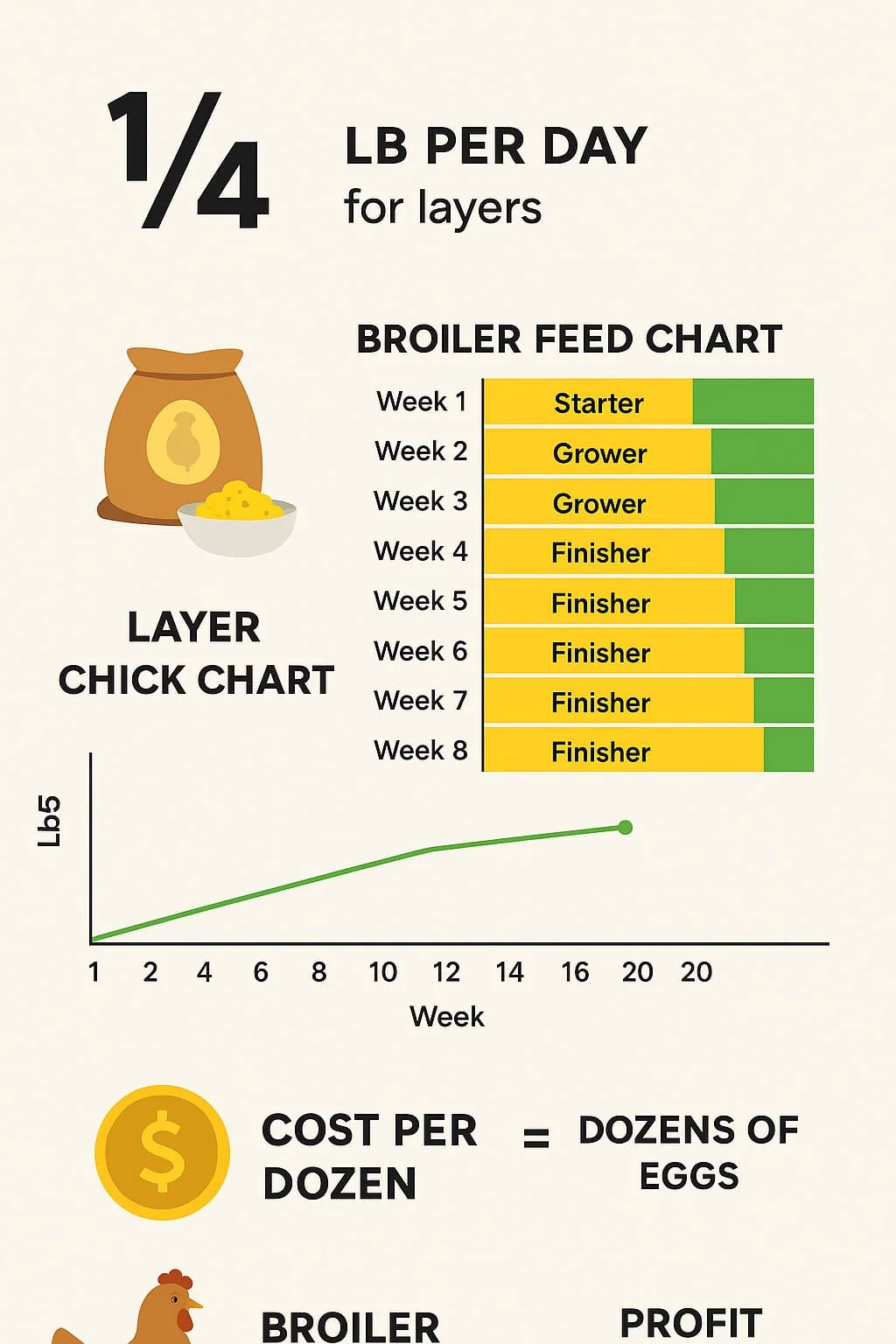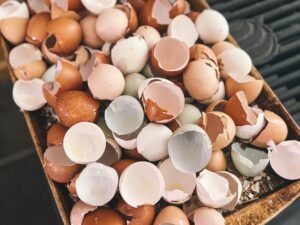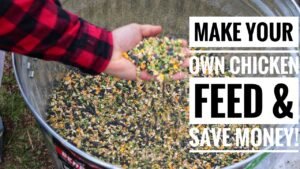The biggest question on every new chicken keeper’s mind isn’t about roosting bars or nesting boxes—it’s, “What is this actually going to cost me?” The largest single expense in any flock is feed, and a tiny mistake in calculation can lead to a huge impact on your budget.
This guide is more than just a simple answer. It’s a complete financial planner for your flock. We will break down feed consumption and costs for a single backyard hen, a full batch of 100 broilers, and a 100-layer operation, complete with easy-to-use calculators.
As someone who has managed everything from a small backyard flock to larger broiler batches for meat, I’ve built the tools in this guide to make your planning simple and accurate.
Quick Answers: The Bottom Line
- Average Layer Hen: Eats about 1/4 lb (1/2 cup) of feed per day.
- 100 Layers (Monthly): Consume about 15 bags (50 lb) of feed.
- Raising 100 Layers to Laying Age (20 weeks): Requires about 50 bags (50 lb) of feed.
- Average Broiler (8 weeks): Needs about 18 lbs of feed.
- 100 Broilers (8-week project): Require about 37 bags (50 lb) of feed.
Looking for the calculator?
Jump straight to the Interactive Feed Calculator »The Fundamentals – Daily Feed for a Single Chicken
How Much Feed Does a Chicken Eat Per Day? The Rule of Thumb
On average, a fully grown laying hen will eat about 1/4 pound (1/2 cup or ~113 grams) of feed per day. This is the golden rule to help you with budgeting for your flock, but it’s just the starting point. This daily consumption rate can be influenced by several factors, which is why a chicken feed calculator is so useful for a realistic budget.
The main reason for this intake is to support their basic metabolism and provide the energy and nutrients needed for egg production. For a large flock, even a small variation in this daily amount can add up to a significant change in your monthly feed costs.
Factors That Influence Feed Consumption
Understanding these factors allows you to fine-tune your budget and feed management.
- Breed Size: A bantam chicken eats far less (around 1/8 lb/day) than a large breed like an Orpington or a Rhode Island Red (which may eat up to 1/3 lb/day). A meat chicken (broiler) will also eat much more than a layer.
- Age: Chicks eat very little, but as they mature, their feed conversion ratio (FCR) and overall intake increases. They transition from
startertogrowertofinisherfeeds, with each stage requiring more total volume of food. - Weather: Chickens eat more in the winter to generate the energy needed to stay warm and eat less in the summer. During heat waves, they will prioritize drinking water over eating.
- Access to Forage: If your chickens are free-ranging and have plenty of access to green grass, grubs, and bugs, they will consume less supplemental feed. This can significantly reduce your feed costs, but it requires that you still provide a complete feed to ensure they are getting all necessary vitamins and minerals.
- Feed Quality: A high-quality feed with the right protein content will satisfy their nutritional needs with a smaller ration, while a poor-quality feed may lead them to eat more to get the nutrients they need.
The 90/10 Rule: Balancing Feed and Treats
For proper nutrition and egg production, a chicken’s diet should be made up of 90% complete feed. This is not a suggestion—it is a critical requirement for a healthy flock. The remaining 10% can be used for supplemental treats like kitchen scraps, scratch grains, or mealworms. This rule ensures they get a balanced diet without filling up on treats that lack the necessary nutrients.
Actionable Tip: To keep your flock healthy, never feed more than a tablespoon or two of treats per bird, per day. A good way to remember is to give treats in the late afternoon after they have had a chance to eat their complete feed.
Don’t Forget Water! The 2:1 Ratio
Water is the most critical element of a chicken’s diet. Chickens typically drink about twice as much water by weight as the feed they eat. A hen that eats 1/4 lb of feed will drink about 1/2 lb (or ~1 cup) of water a day. Dehydration is a major cause of death and can stop egg production completely.
Pro-Tip: Check your flock’s water supply at least twice a day, especially in warm weather. A chicken in heat stress will stop eating and die if they don’t have access to cool, fresh water. Signs of dehydration include panting, a pale comb, and lethargy.
The Importance of Grit and Oyster Shell
Chickens without access to outdoor foraging need grit to grind up their food, and laying hens need a source of calcium to produce strong eggshells. You must provide them with both. Place grit and oyster shell in a separate feeder so your chickens can consume it on an as-needed basis.
Chicken Feed Calculator
Quickly estimate feed costs for your flock.
Layers Advanced Options
Enter your details and click ‘Calculate’ to see the results.
The Broiler Project – Calculating Feed for Meat Birds (A to Z): How Many Bags of Feed for 100 Broilers? A Complete Walkthrough
Unlike an ongoing laying operation, raising broiler chickens is a finite project, usually lasting about 6 to 8 weeks. Here is a step-by-step calculator to help you figure out exactly how much feed you will need.
Step 1: Understanding Broiler Feed Stages
Broilers require different protein content at each stage of their life to support their rapid growth. This is crucial for their overall health and metabolism.
- Starter (Weeks 1-3): High protein (22-24%). It is usually a fine crumble to make it easy for small chicks to eat.
- Grower (Weeks 4-6): Medium protein (18-20%).
- Finisher (Weeks 7-8): Lower protein (16-18%).
Step 2: Broiler Feed Consumption Chart (Per Bird, Per Week)
This chart shows the average feed consumption for a single broiler chicken over an 8-week period.
| Week | Feed Type | Lbs per Week | Cumulative Lbs |
|---|---|---|---|
| 1 | Starter | 0.4 | 0.4 |
| 2 | Starter | 0.9 | 1.3 |
| 3 | Starter | 1.5 | 2.8 |
| 4 | Grower | 2.0 | 4.8 |
| 5 | Grower | 2.8 | 7.6 |
| 6 | Finisher | 3.5 | 11.1 |
| 7 | Finisher | 3.5 | 14.6 |
| 8 | Finisher | 3.5 | 18.1 |
Note: This chart is an estimate. Actual consumption may vary due to breed and environmental conditions.
Step 3: The 100-Broiler Feed Calculator
Using the chart above, let’s calculate the total amount of feed for a batch of 100 broilers over 8 weeks.
- Total Feed Needed (in lbs): (Total cumulative lbs per bird from chart) x (Number of birds)
- For an 8-week project: 18.1 lbs/bird x 100 birds = 1,810 lbs of feed.
Now, let’s convert that into bags. Most standard bags are 50 lbs.
- Total Bags Needed: (Total Feed Needed) / (Lbs per bag)
- 1,810 lbs / 50 lbs = 36.2 bags.
- Round up to 37 bags to be safe and account for spillage.
Use our interactive calculator above to get a personalized estimate for your flock size and feed cost.
The Broiler Project Cost Breakdown
Let’s assume the average cost of a 50 lb bag of chicken feed is $25. Your total operational cost for feed would be:
- Total Feed Cost: (Number of Bags) x (Cost Per Bag)
- 37 bags x $25/bag = $925.
Calculating Broiler Profitability (ROI)
This is a powerful metric that transforms your budget from a simple cost calculation to a profitability planner. Here is a simple formula to determine your potential profit per bird.
- The Formula: (Sale Price per Bird) – (Cost of Chick + Total Feed Cost per Bird) = Profit Per Bird.
- Example: Based on our 100-broiler project, if you sell each bird for $25:
- $25 sale price – ($4 chick + $23.13 feed cost) = -$2.13 Loss Per Bird.
- This example shows the importance of accurate budgeting and demonstrates that without optimizing costs or increasing sale prices, a batch of broilers can result in a loss.
- Note: This calculation only accounts for feed and chick costs. You must also factor in other expenses such as housing, electricity for heat lamps, medication, and processing fees to get a complete picture of your profitability.
A Note for Nigerian Farmers (and International Readers)
In many parts of the world, including Nigeria, feed bags are sold in 25 kg sacks. To calculate for this bag size, you need to first convert your total feed needed from pounds to kilograms.
- Conversion: 1 lb = 0.4536 kg
- Total Feed Needed (in kg): 1,810 lbs x 0.4536 kg/lb = 821 kg
- Total Bags Needed (25 kg bags): 821 kg / 25 kg = 32.84 bags
Round up to 33 bags and use your local feed cost for the most accurate budget.
“Nigerian farmers seeking specific local calculations should see our detailed guide on broiler feed requirements for Nigeria with 25kg bag calculations and current market prices.”The Full Layer Lifecycle: Feed Calculation from Chick to Point-of-Lay (Weeks 1-20)
This is the biggest content gap in most guides—the cost of raising a laying hen before she ever produces an egg. The first 20 weeks are a major investment, and proper budgeting for this “startup” phase is crucial. The goal here is healthy, steady growth, not rapid weight gain.
Layer Chick & Pullet Feed Consumption Chart
| Age (Weeks) | Feed Type | Lbs per Week (per bird) | Cumulative Lbs |
|---|---|---|---|
| 1-6 | Starter (20% protein) | ~1.5 (avg over period) | ~2.0 |
| 7-14 | Grower (16-18% protein) | ~1.5 | ~14.0 |
| 15-20 | Developer/Finisher (16%) | ~1.75 | ~24.5 |
The Calculation
Based on the chart above, to raise one laying hen to point-of-lay at 20 weeks, you will need approximately 25 lbs of feed. This is a combination of chick starter and grower feed, specifically formulated for bone and organ development.
The Cost
To raise a small flock of 100 laying hens, you will need:
- Total Feed Needed: 25 lbs/bird x 100 birds = 2,500 lbs of feed.
- Total Bags Needed: 2,500 lbs / 50 lb bags = 50 bags.
This shows that you need to purchase 50 bags of feed just to get your flock to laying age. This is a staggering but essential number for an accurate budget.
The Layer Operation – Budgeting for Your Egg-Laying Flock
Budgeting for a layer flock is a key part of answering the ultimate question: is raising your own chickens for eggs actually cheaper?
How Many Bags of Feed for 100 Layers Per Month?
Once your hens reach point-of-lay (around 20 weeks), they transition to a long-term budgeting project. Here is how you can calculate your ongoing monthly feed costs. We will use our rule of thumb from Part 1.
Step 1: The Daily Calculation
- Daily Feed for 100 Hens: (lbs per hen per day) x (Number of hens)
- 0.25 lbs x 100 hens = 25 lbs of feed per day.
Step 2: The Monthly Calculation
- Monthly Feed for 100 Hens: (lbs per day) x (Days in month)
- 25 lbs/day x 30 days = 750 lbs of feed per month.
Step 3: Calculating Bags and Cost
- Monthly Bags Needed: (Monthly lbs) / (Lbs per bag)
- 750 lbs / 50 lb bags = 15 bags per month.
Assuming the same cost of $25 per 50 lb bag, your monthly chicken feed cost would be:
- Monthly Feed Cost: (Number of Bags) x (Cost Per Bag)
- 15 bags x $25/bag = $375 per month.
Ready to budget for your flock? Jump back to the calculator for a quick cost breakdown.
Calculating Your “Cost Per Dozen Eggs”
This is an incredibly powerful metric for anyone who wants to sell eggs or simply track the true value of their flock. This calculation shows you what it costs you to produce each dozen eggs, based on feed cost alone.
- The Formula: (Monthly Feed Cost) / (Total Dozens of Eggs Laid Per Month) = Cost Per Dozen.
- Example: If your 100 hens lay an average of 80 eggs per day, that’s 2,400 eggs a month, or 200 dozen.
- $375 feed cost / 200 dozen eggs = $1.88 per dozen in feed costs.
Monthly Feed Estimates for Different Flock Sizes (Table)
Use this table to quickly find your monthly feed needs and estimated costs for different flock sizes.
| Flock Size | Lbs per Month | Approx. # of 50 lb Bags | Approx. # of 25 kg Bags |
|---|---|---|---|
| 50 Layers | 375 | 7.5 | ~7 |
| 100 Layers | 750 | 15 | ~14 |
| 200 Layers | 1500 | 30 | ~28 |
| 500 Layers | 3750 | 75 | ~69 |
| 1000 Layers | 7500 | 150 | ~137 |
Cost-Saving Strategies for a Layer Flock
- Ferment Your Feed: Fermenting feed makes it more digestible, meaning your chickens will eat less and still get the same nutritional value. This is a great way to save money on your long-term feed costs.
Troubleshooting Common Feeding Problems
Every chicken keeper runs into common problems with feeding. Knowing how to handle these issues will save you money, time, and stress.
Problem: Bullying and Feed Guarding
Solution: This is a common issue with flock dynamics. The solution is to provide more feeding stations than you think you need. Placing multiple feeders in different locations around the coop or run will allow less dominant hens to eat in peace. A good rule of thumb is to have enough feeder space for at least half the flock to eat at once.
Problem: Pests (Rodents & Insects) in the Feed
Solution: Pests are a huge problem and can spoil feed quickly. The best way to prevent this is to store feed in airtight, metal containers. Never leave bags open or exposed. For insects like weevils, you can freeze a small amount of feed for 48 hours before use to kill any weevil eggs.
Problem: My Feed Got Wet! Is it Ruined?
Solution: Unfortunately, wet feed is a ticking time bomb. It can mold within 24-48 hours, which is highly toxic to chickens and can cause severe illness or death. If it’s just a small amount, you can feed it to the flock immediately as a wet mash. If a large amount of feed got soaked or if it has a sour/musty smell, it must be discarded to prevent illness.
Problem: I Ran Out of Feed! What Can I Do?
Solution: This is an emergency. While you should get proper feed as soon as possible, you can create a short-term emergency mash to get you through 24-48 hours. Mix together equal parts oats, cornmeal, and scrambled eggs (cooked, without salt or oil). You can also add kitchen scraps like wilted greens or fruit peels. This is not a complete meal, but it will provide enough nutrients to keep your flock healthy until you can restock.
Advanced Questions & FAQ
Is It Cheaper to Make Your Own Chicken Food?
For the average backyard keeper, it is almost never cheaper to make your own feed from scratch. While individual ingredients may seem inexpensive, the equipment for grinding and mixing is costly, and the process of creating a perfectly balanced feed with the right protein, calcium (oyster shell), and grit is incredibly difficult and time-consuming. Commercial feeds are formulated by professionals to ensure optimal health and production. However, if you’re interested in the process, you can learn more about it.
Do Chickens Stop Eating When They Are Full?
Yes, chickens are excellent at self-regulating their food intake. This is why the standard practice is to free-feed them by having feed available at all times. They will eat what they need and then stop.
How Long Can Chickens Go Without Food?
A healthy adult chicken can survive for a few days without food, but it is highly stressful and will quickly lead to a loss of weight and a drop in egg production. They can only go a few hours without water, especially in hot weather. Constant access to both feed and water is a must.
How Do I Calculate Feed for a Mixed Flock (Different Ages/Breeds)?
For a small mixed flock, the easiest method is to use the 0.25 lbs per day per hen rule of thumb as a general average. For a large mixed flock, you should consider separating the birds by age or breed so you can provide them with the appropriate feed.
How much feed is needed for 25 chickens?
Based on the average daily consumption of 0.25 lbs per hen, a flock of 25 chickens will eat 6.25 lbs of feed per day. This equates to about 188 lbs per month, or just under four 50 lb bags.
How much does chicken feed cost per year?
Using the calculations for 100 layers, the feed would cost roughly $4,500 per year (12 months x $375/month). This is based on a cost of $25 per 50 lb bag. For a full breakdown of all expenses, see our guide to the total cost of raising chickens.
How much feed does a broiler chicken eat in 40 days?
A broiler chicken will eat approximately 8.6 lbs of feed in its first 40 days (about 5.7 weeks). This is a mix of starter and grower feed, based on the Broiler Feed Consumption Chart above.
How many bags of feed for 50 broilers for 6 weeks?
According to the consumption chart, a broiler eats a total of 11.1 lbs of feed over 6 weeks. To feed 50 broilers, you would need:
Total Feed Needed: 11.1 lbs/bird x 50 birds = 555 lbs
Total Bags Needed: 555 lbs / 50 lb bags = 11.1 bags.
You would need to purchase 12 bags to have enough feed.
How much is a bag of chicken feed in Nigeria?
Chicken feed in Nigeria is typically sold in 25 kg bags. The price can vary significantly depending on the brand, quality, and location. You should always check with your local agricultural suppliers for the most up-to-date pricing.
Conclusion
Knowing how much feed a chicken eats is the most important part of your budgeting and planning. As you’ve seen, a laying hen eats about 1/4 lb per day, while a broiler needs about 18 lbs of feed over 8 weeks. With the addition of the new chick-to-pullet section, you now have a complete financial blueprint for any type of chicken-keeping journey.
Use these simple formulas with your local bag sizes and prices for a truly accurate budget. Careful planning will help you raise a healthy and productive flock without any financial surprises.
Disclaimer: All calculations are estimates. Actual consumption can vary. This guide is for educational purposes and is not a substitute for professional nutritional or veterinary advice.

Oladepo Babatunde is the founder of ChickenStarter.com. He is a backyard chicken keeper and educator who specializes in helping beginners raise healthy flocks, particularly in warm climates. His expertise comes from years of hands-on experience building coops, treating common chicken ailments, and solving flock management issues. His own happy hens are a testament to his methods, laying 25-30 eggs weekly.



